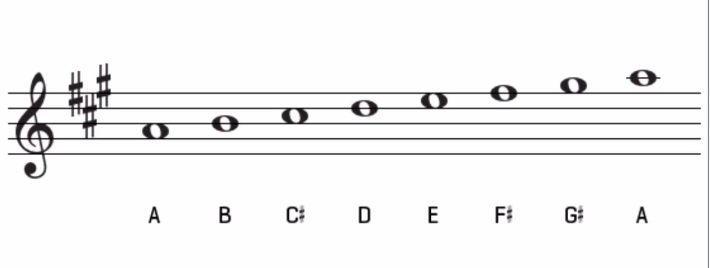In this lesson, we are going to easily learn to play the melodic minor scale. What is great about this melodic minor scale is that it is the easiest of all minor scales to produce. You only need to alter one note in the major scale it comes out of.

The Major Scale = all notes in their natural position.
A B C# D E F# G#

If we flatten the 3rd, 6th, and 7th notes, we get the A minor scale. Anytime you flatten these three notes in any major scale, you will create the minor scale. So, if you're in D major, you flatten the 3rd, 6th, & 7th notes, and you'll get the D minor scale. Understand? This works with all major scales.
All minor scales come from their major scale counterparts. So, for every major scale, we have a natural minor scale. And with an alteration of certain notes, we can create many other minor scales, including the melodic minor scale.
Watch The Video Lesson Below
7 magical notes
The major scale is comprised of 7 notes. The famous Do Re Mi that we are so familiar with. It is usually the first thing that we are introduced to in music. Usually in grade school.
Let’s look at the A major scale, for example:
A B C# D E F# G# A.
This scale is made up of the Do Re Mi Fa So La Ti Do that we are familiar with. This tells us that it is a major scale. If it doesn’t have this, it is not a major scale. All major scales should have this sound.
The A minor scale = flat 3rd, 6th, and 7th notes.
A B C D E F G A

The minor scale is very similar to the major scale, except that to create it, we need to alter a few notes of the scale. We need to flatten (take back by one fret) the 3rd, 6th, and 7th notes. This will give us an interval of notes with a different tone quality and mood to work with.
The A minor scale: A B C D E F G A. As you can see from the note sequence, we have now eliminated all of the sharpened notes in the major scale. We had the C#, F#, & G#. Now they are just natural C, F, & G. This is because they are the 3rd, 6th, & 7th notes of the scale.
This is how a minor scale can be created in any key. So, if you ever want to make a major key into a minor one, all you need to do is find the 8 notes to the key and flatten the 3rd, 6th, & 7th by one fret, and you're set.
The Melodic minor scale = flattened the 3rd note.
A B C D E F# G# A

This is the easiest scale to produce. Why? You only need to flatten one note. The third. That’s it. Just one note. You leave the 6th and 7th notes in their natural position.
Let’s look at the example in the key of A major. The notes for A major are A, B C# D E F# G# A. We now know that the third note is C#. So, we just bring this note back by one fret, and we have the A melodic minor scale. Now, the notes in this scale are A, B, C, D, E, F#, G#, and A.
If you play this scale, you’ll see how just changing this one note makes a big difference in the sound of the scale.
Minor pentatonic scales





When it comes to the major scale, there is only one. But when it comes to minor scales, there are many. You’ve got the natural minor scale, the harmonic scale, minor pentatonic scales, and many more. But in reality, these are just different versions of each other.
The main thing in the minor scale is to have the fat third. Like in the melodic minor scale. The minor pentatonic scale has a flat 3rd, & 7th in it. The blues scale (a form of minor scale) has the flat 5th added in for good measure. The harmonic minor scale has the flat 6th note in it.
Study the guitar fretboard

Study the guitar fretboard
It is very important to learn your notes and study the guitar fretboard. When you look at it like the picture shown above, you can see there is much mystery to it, and if you take the time to unlock the mystery, you’ll become a much better player.
You will also improve your understanding of music theory and how certain notes work together in harmony to create beautiful music. But to accomplish this, you must study. You must study and practice this information daily.
Dive deeper step-by-step
If you’d like to learn more about the melodic minor scale and other scales like it, I recommend you check out the book I authored and self-published.
Lead Guitar Wizardry Vol. 2

Lead Guitar Wizardry will show you everything you need to take your lead guitar playing to the next level. It continues where Lead Guitar Wizardry Volume 1 leaves off.
It introduces you to:
Pentatonic scale guitar licks
The 7 modes of the major scale
Guitar licks within the modes
Scale mode formulas
Additional minor scales
Modal triad relationships
How to improvise
Sweep picking arpeggios
And many, many more things.
If you’re looking to enhance your guitar soloing and knowledge of music theory, I recommend you look into the book Lead Guitar Wizardry Vol 2.
Study and practice daily
In this lesson, we have looked at the melodic minor scale and learned how it is different from the natural minor scale. All scales are just a matter of intervals. The difference between them is the interval pattern. I suggest you commit this to memory as it will help you to understand them better.
Private instruction is also available
I also offer private guitar lessons. These can be a fun way to learn as they offer multiple benefits and make learning fun. If this catches your interest, contact me at my website, and we'll set up a time to talk on the phone. Learning to play guitar is not always easy, but with the right training, it can become easier and a lot more fun to learn.
Keep practicing daily, and let me know if you need any help.
Best of luck, Sincerely, Dwayne Jenkins


